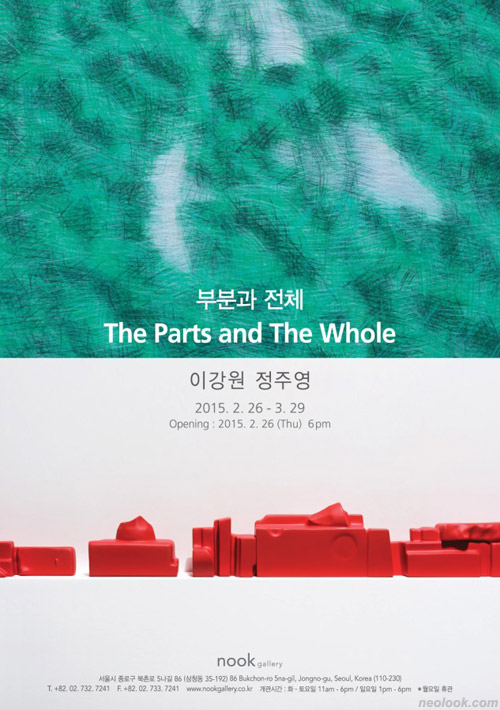- ● homepage
- ● archives
- ● restoration
- ● books
- ● big banners
- ● post board
- ■ neo's search
- ■ about us
- ■ 게재방법 안내
- 개인정보처리방침

- [email protected]
- Tel. 02_335_7922
- Fax. 02_335_7929
- 10:00am~04:30pm
- 월요일~금요일
- 3/3(월) 대체공휴일

부분과 전체 The Parts and The Whole
이강원_정주영 2인展 2015_0226 ▶ 2015_0329 / 월요일 휴관
초대일시 / 2015_0226_목요일_06:00pm
관람시간 / 11:00am~06:00pm / 일요일_01:00pm~06:00pm / 월요일 휴관
누크갤러리 NOOK GALLERY 서울 종로구 북촌로 5나길 86(삼청동 35-192번지) Tel. +82.2.732.7241 www.facebook.com/nookgallery
화면 가득 가는 선의 붓질이 겹치고 겹쳐 녹색의 숲을 이룬다. 가까이 다가갈수록 형태는 사라지고 오로지 선들만이 남아있다. 겹겹이 쌓인 수많은 선들의 엇갈림은 추상의 감동을 주고 선들의 축적은 산의 모습을 드러낸다.

- 정주영_남산 No. 5-1,2,3_리넨에 유채_55×50cm×3_2014
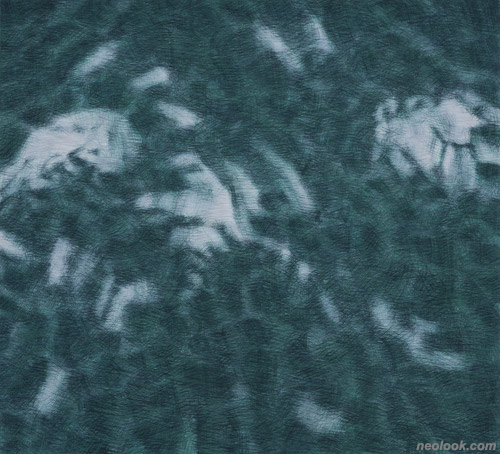
- 정주영_북악산 No.35_리넨에 유채_100×110cm_2014
정주영은 전체 산의 풍경을 그리는 것이 아니라 산을 반복적으로 바라보는 가운데 자신의 눈에 들어온 한 부분을 끌어당겨 프레이밍하고 그 표정을 생경한 붓터치로 집중해서 그려낸다. 부분의 추상이미지가 모여서 전체 풍경이미지를 이룬다. 이번 전시 작품에서 보여주는 겹쳐 그리는 기법은 오랜 시간 많은 반복을 통하여 완성도를 더해 안정되고 편안해진 작가의 마음을 보는 듯하다. 정주영은 동일한 대상을 반복해서 그린다. 자기 반복을 통해 같은 산을 그리지만 항상 다르게 그려진다.

- 정주영_북악산 No.36_리넨에 유채_130×120cm_2014

- 정주영_북한산 No.21-1,2,3_리넨에 유채_50×45cm×3_2014
이강원은 일상의 이미지들을 모아 풍경이미지를 만든다. 일상의 파편들이 쌓여서 숲이 되고 대지가 된다. 추상의 파편들을 늘어놓으면 스카이라인이 되기도 한다. 풍경조각의 부분을 가까이 들여다보면 나뭇잎 문양의 몰딩이 보이고 물 컵의 파편, 자갈모양의 타일, 벽돌의 깨진 조각들이 보인다. 주변에서 발견한 구체적인 사물들의 의미와 흔적을 따라가며 만들어낸 조각들은 부분이 되고, 부분이 모여 전체가 되어 추상이미지를 만들고 우리가 사는 세상의 이야기를 담은 풍경이 된다. 각 부분의 조각들은 작가의 지극한 노동을 거쳐 전체적인 이미지를 만들어 나간다.
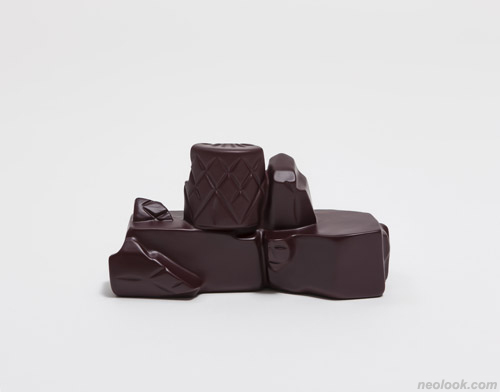
- 이강원_물_레진_11.2×21.5×8.3cm_2014

- 이강원_숲_브론즈_38×49×42.5cm_2015
대상의 한 부분을 클로즈업하여 추상적인 이미지를 구성하고 다시 멀리서 바라보는 풍경을 제시하는 정주영과 이강원은 풍경이라는 주제를 각자의 시각으로 바라본다. 정주영은 어떤 시선으로 산을, 풍경을 바라보는 것일까? 언제나 변함없이 자리를 지키고 있는 산에서 오랜 시간의 흔적을 찾으려는 것인가? 아니면 그 속에서 자신의 부분을 찾으려는 건가? 이강원은 물성 강한 오브제들에 은유적인 의미를 부여한다. 나뭇잎문양의 몰딩은 숲으로, 자갈이나 벽돌의 파편들은 대지로 은유 된다. 앞으로 작가의 눈에 또 어떤 사물이 들어와 다른 풍경으로 은유 될지 호기심을 불러온다. ● 이들의 작업은 부분의 이미지를 통해 전체를 보여주고 전체의 이미지는 다시 부분을 주시하게 만든다. 이번 전시에서 함께하는 두 작업은 서로 다른 매체이지만 어느 위치에서 어떤 시각으로 작품을 보는가에 따라 또는 보는 이의 상황에 따라 달라지는 복합적인 경험을 자아내리라 기대한다. ■ 조정란
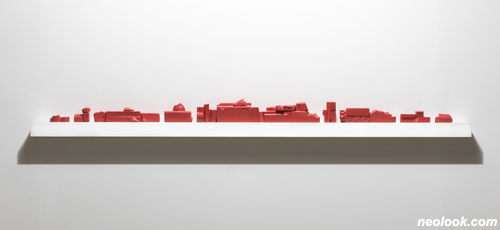
- 이강원_스카이라인_레진_22.5×264×12cm_2015
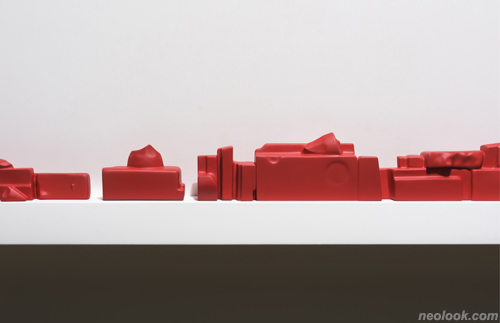
- 이강원_스카이라인_레진_22.5×264×12cm_2015_부분
Thin linear brush strokes are painted in overlapping layers that cover the entire picture-plane to form a green forest. As you get closer, the shapes disappear and only the lines remain. The many stacks of intersecting lines create an abstraction that moves the emotions of viewers, but from a distance the accumulated lines reveal the shape of a mountain. Zuyoung Chung does not paint the overall landscape of the mountains, but zooms into a particular part that comes into her view as she looks at it repeatedly, which she frames. Then she paints its expressions intensively in raw brush strokes. Partial abstract images gather to form the whole image of the landscape. The overlapping technique used in the works shown in this exhibition seem to reflect the artist's state of mind, which has become more stable and comfortable through a high level of completion achieved by numerous repetitions over an extensive period. Chung paints the same subject over and over. She paints the same mountain through self-repetition, but it is always painted differently. ● Lee Kangwon gathers images from everyday life to make landscape images. Fragments of the everyday pile up to become forest and land. The abstract fragments can be arranged to form a skyline. If we take a close look at parts of the landscape sculptures, we can see leaf-shaped molding, fragments of a water cup, pebble-shaped tiles, and broken pieces of brick. The sculptures made by following the meanings and traces of concrete objects discovered in the artist's surroundings become the parts. The parts join as a whole to form abstract images, which then become landscapes containing stories about the world we live in. The pieces of each part form the whole image through extreme labor by the artist. ● Artists Zuyoung Chung and Lee Kangwon, who take close-ups of certain parts of objects, compose abstract images from them, and then present landscapes viewed from far away, look at the subject of landscape through their own individual perspectives. What is the viewpoint of Zuyoung Chung when she looks at the mountains, the landscapes? Is she searching for ancient traces of time in the mountain, which has always been there without change? Or is she looking for a part of herself there? Meanwhile, Lee Kangwon gives metaphoric significance to objects with strong material properties. Leaf-shape molding is used as a metaphor for a forest, while pebbles or fragments of bricks represent the land. The works provoke our curiosity: what kinds of objects will catch the attention of the artist and be transformed into different metaphorical landscapes? Both artists' works show the whole through images of the parts, and the whole image makes us look again and more closely at the parts. The two bodies of works in this exhibition consist of completely different media, but are expected to evoke complex experiences depending on the positions, perspectives and situations of spectators. ■ JUNGRAN CHUNG
Vol.20150226c | 부분과 전체 The Parts and The Whole-이강원_정주영 2인展

